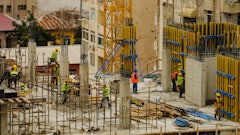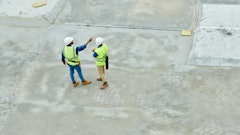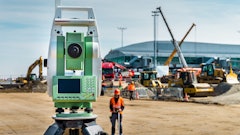
As the construction industry modernizes with help of established and emerging technologies, some of these newer technologies are bellwethers for where enterprise software will take construction in the next several years.
While many construction business, accounting, field productivity and project management softwares essentially digitize the cow paths of historical construction workflows, other software products will enable net new, more efficient processes that could help construction catch up with other industries in profitability, on-time project delivery and cost control. Some of these, like Higharc, reimagine construction workflows for high-volume homebuilding, delivering the repeatability and standardization benefits that come with scale while enabling configuration for uniqueness. This software approach will be necessary to help construction manage the complexity required to deliver seemingly unique assets based on standard content and repeatable processes.
Design Standardization
While Higharc is aimed more at design, this philosophy can influence the operational side of construction, once a project enters work-in-progress (WIP). But standard design elements along the lines of what Higharc facilitates start to drive benefits already at estimating.
Estimating is where CostCertified started as it built out its software suite, also targeting homebuilders. The goal was to not just streamline the estimate but give the customer the ability to select options and finishes and have those choices automatically flow through quantities and pricing. The company then added customer relationship management (CRM) and project management. CostCertified targets smaller contractors and partners with external parties to generate 3D home designs and renderings, which differentiates it from Higharc, which is a fully functional building information management (BIM) application designed specifically for large scale home builders and developers. But these and other emerging products suggest a shift in construction towards more standardization, which is good.
At the same time, both of these products give users a web-based configurator so a builder’s customer can change project elements and have those changes flow through quantities and pricing in the back end. Rules-based configuration is something product-centric businesses have used for a long time to customize products, from vehicles with standard and optional features to industrial equipment that repurposes designs but meets customer requirement by modifying a product master to create distinct but predictable configured products.
Stream our full IRONPROS Product Snapshot Video on CostCertified.
Software for Large Scale Homebuilders
Higharc was founded in 2018 by a particularly well-credentialed team with senior experience at Autodesk, Augmenta and in 3D printing technology. The goal was to deliver software for the production home builders that Higharc Cofounder and CEO Marc Minor says design and bring to market about 80% of homes.
“The biggest problem in homebuilding is that the builders are trying to bring homes to market like products, meaning you're trying to standardize, and then roll these things out everywhere you operate,” Minor said in an April discovery call with IRONPROS. “Then you get benefits of scale. It's just totally different than one off buildings. But the problem is that homes tend to change radically in many ways for code compliance and because buyers have choices for geography reasons. And those changes add up. And it creates just an incredible complexity that travels downstream and creates waste, not only time-based waste, but also direct cost waste across the value chain.”
Waste in a production home building setting can come from design from rework and errors or waste in the field due to unclear permit sets.
“We seek to route that waste out,” Minor said. “And we do that by automatically managing the digital twin. We replace AutoCAD, we replace Revit. There are many businesses out there who are building more pedestrian tools focused on project management, which is a valuable thing. But it kind of moves the problem around and doesn't really solve the problem for homebuilding.”
Configured Designs for Construction
Higharc configures home designs based on a rules engine, accounting for specified design elements, local code and building systems including timber frame, concrete, concrete masonry unit and brick. As design elements are specified in Higharc, the software uses that data to build out a bill of materials (BOM). This addresses a serious pain point of production homebuilders.
“Many home builders still use lump sum contracts with their subcontractors,” Minor said. “They can't even become unitized if they don't actually have quantities. So, the accuracy of their bids is pretty much all over the place. First and foremost, what we do is we automatically generate takeoffs, not just generic takeoffs, but very specific to the actual house because we have the full building model. And because the whole thing is generated by data, we can traverse every element count and then provide a takeoff in 3D. This isn't the kind of format that the ERP can ingest to go straight to purchase order. It’s hard to express just how paradigm shifting that is for builders, who today are giving a set of 2D documents to trades and saying, please go estimate this and then the trade comes back to them with a bid that has a lump sum price, or at best, it gives them a price for materials and a price for labor.”
But Higharc can do more than just spitting off a BOM. Rather, it can spit off a near infinite number of BOMs to accommodate all of the different variables on the standard project.
“The main thing is being able to automatically update that data based on whatever is different,” Minor said. “A given production home, even one that's fairly simplistic, can easily have 10s of millions of unique versions of itself. A tract style house has perhaps 18 option categories—an option category can be garage hand left, which is basically mirroring the house. Another option category could be foundation type, crawlspace, monolithic slab, whatever. Another option category could be a buyer-facing decision—the buyer wants the wraparound front porch, or the buyer wants the upgraded master.”
The inability to deal with this complexity is the root cause, according to Minor, for production homebuilders’ retrograde approach of getting lump sum bids and choosing the lowest price.
“They're really not value engineering, not the way you see in manufacturing or even these days with commercial construction,” Minor said. “They’re not really thinking it through upfront because they can't. We give them the data to do that. And we manage all those variations automatically with a tool we call Procure. And it automatically syncs with their ERP, which means you can go to purchase order and save literally days off every single house that gets built. if not weeks, depending on the builder.”
Higharc Tech Stack
Higharc is a multitenant software-as-a-service (SaaS) BIM application built around a proprietary browser-based geometry kernel and provisioned on Amazon Web Services (AWS). The team builds its browser-based interface with JavaScript with at least some use of TypeScript.
“When we started the company, we knew that the only way to solve some of these core problems in homebuilding with representation of homes as real data in an easy and cross-departmental way was to go browser-based,” Minor said. “And that meant we had to build a geometry kernel first, specifically for the web, and specifically for the browser. And the reason that's important is because it needed to be lightning fast. And then we built on top of that a whole layer of systems for generating homes directly from data. If you're a builder, you have a set of construction standards, constraints, goals and rules for different communities and locations. And when you draw houses in our system, when you draw a rectangle, for example, what you actually see is a full house-like box. And that's because we're taking all your rules and regenerating the beginnings of a house automatically given those rules.”
The application does its heavy lifting inside the browser rather than continually pulling data off the cloud. This makes for a spritelier user experience and enables the application to tolerate low-quality or broken connections.
Higharc Pricing and Market
Higharc is sold on an unlimited user model based on the size of the customer’s business.
“The first couple of years, we give them a ramp up because we know that it takes time to fully onboard the whole business and translate how you operate, particularly if you're bigger business,” Minor said. “So typically, there’s a ramp up to the full price by the third year. It also depends on the complexity of what they do and the products they use that kind of thing.”
While Higharc ramps to its full price point over a period of years, implementations take only about 30 to 120 days.
“What we do for implementation is different than how the builder ramps it up into their whole organization,” Minor said. “If I’ve got a community in flight already using the plan sets, I already have, that's more complicated than if they’ve got a new community opening up at the end of the year. So how the builder chooses to transition their business over is up to the builder. We work with them on that, but it can take time, particularly if you have multiple divisions.”
Higharc has a robust customer success function, with each customer getting a designated contact, with these Higharc contacts coming to the account with constructions operations or supervisory experience.
Production home builders constructing more than 100 homes per year will start to find Higharc attractive. That translates to, depending on geography, between $30 million per year and larger, up to billions of dollars in annualized construction volume. The company also services build-to-rent.
Minor said Higharc does plan to develop and offer a specific product for smaller builders, with that product being accessible for online purchase with the current offering is sold through the sales team, which qualifies and works closely with the prospect as they transition into a customer.
BOTTOM LINE: Higharc has a compelling value proposition for large production homebuilders, and with its pending product for smaller builders could be attractive to them too. The company has strong, seasoned leadership and $27 million in venture capital and a unique value proposition for a large and well-defined market. This makes Higharc of interest to production homebuilders including the 100 largest which according to the Harvard Joint Center for Housing Studies are now behind most homes built in the United States. But Higharc is of interest to construction technologists and executives as well because it demonstrates the direction the industry could take—away from one-off designs and towards standard designs with standard components, standard inventory and more predictable project outcomes. Construction technology must enable this transition, and we will be following that trend closely here on IRONPROS.

























